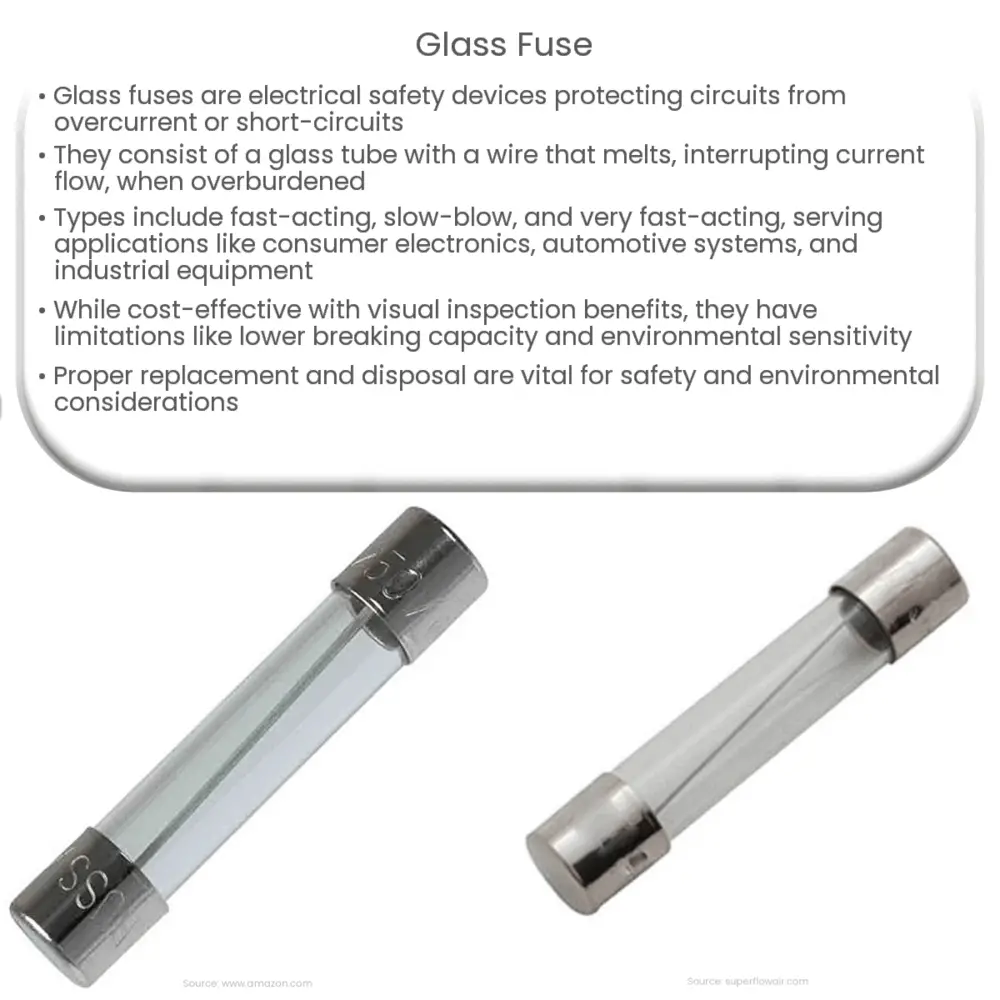Glass fuses are compact, cost-effective electrical safety devices that protect circuits from overcurrent and short-circuits in various applications.

Glass Fuse: An Overview and Its Applications
Glass fuses are a type of electrical safety device designed to protect electrical circuits from damage caused by overcurrent or short-circuit conditions. They are widely used in various electronic devices and appliances to ensure safe and reliable operation. This article provides an overview of glass fuses, including their construction, types, and applications.
Construction of Glass Fuses
Glass fuses consist of a glass tube, usually made of soda-lime or borosilicate glass, that houses a thin wire or filament made from materials like tin, zinc, or copper. This wire is designed to melt when the current passing through it exceeds a specific threshold, known as the fuse’s rated current. Once the wire melts, it breaks the electrical connection and interrupts the flow of current, thereby protecting the circuit from further damage.
Types of Glass Fuses
There are several types of glass fuses, each designed to meet specific electrical and thermal requirements. The most common types include:
- Fast-acting fuses: These fuses respond quickly to overcurrent conditions and are designed to protect sensitive electronic components from damage. They are commonly used in devices with semiconductor components, such as computers, televisions, and audio equipment.
- Slow-blow fuses: Also known as time-delay fuses, slow-blow fuses are designed to handle brief current surges without blowing. They are typically used in circuits with inductive loads, such as motors and transformers, which can generate temporary current surges during startup or operation.
- Very fast-acting fuses: These fuses provide extremely fast response times to protect against high-speed, high-energy events, such as voltage spikes or electrostatic discharges. They are often used in specialized applications like telecommunications equipment, medical devices, and military systems.
Applications of Glass Fuses
Glass fuses are used in a wide range of applications due to their versatility, low cost, and ease of installation. Some common applications include:
- Consumer electronics: Glass fuses are frequently used in consumer electronics like TVs, radios, and gaming consoles to protect sensitive components from damage due to overcurrent conditions.
- Automotive systems: Fuses are an essential component of automotive electrical systems, protecting critical components such as engine control modules, lighting systems, and power accessories from damage.
- Industrial equipment: Glass fuses are used in various industrial equipment and machinery, including manufacturing automation systems, power distribution panels, and motor control centers, to safeguard against electrical faults and ensure safe operation.
Selection and Rating of Glass Fuses
When selecting a glass fuse for a particular application, it is crucial to consider factors such as the fuse’s rated current, voltage, and breaking capacity. The rated current should be chosen based on the maximum current the circuit is designed to handle under normal operating conditions. It is essential to select a fuse with a voltage rating equal to or higher than the circuit’s maximum voltage to ensure safe operation. The breaking capacity, also known as the interrupting rating, refers to the maximum current the fuse can safely interrupt without causing damage to the surrounding components or equipment.
Advantages and Disadvantages of Glass Fuses
Glass fuses offer several advantages, such as:
- Cost-effectiveness: Glass fuses are generally less expensive than other types of fuses, making them an attractive choice for many applications.
- Visual inspection: The transparent glass tube allows for easy visual inspection to determine if the fuse has blown, simplifying maintenance and troubleshooting.
- Compact size: Glass fuses are typically smaller than other fuse types, making them suitable for space-constrained applications.
However, glass fuses also have some disadvantages:
- Lower breaking capacity: Glass fuses generally have a lower breaking capacity compared to other fuse types, limiting their use in high-power applications.
- Environmental sensitivity: Glass fuses can be affected by temperature and humidity changes, which may cause them to age and fail prematurely.
- No indication of fault: Unlike some other fuses, glass fuses do not provide an indication of the type of fault that caused them to blow, making it more challenging to diagnose and resolve issues.
Replacing and Disposing of Glass Fuses
When replacing a blown glass fuse, it is essential to choose a fuse with the same specifications as the original to maintain the circuit’s safety and integrity. Disconnect power to the device or circuit before attempting to replace the fuse. To remove the blown fuse, gently pull it from its holder using needle-nose pliers or a specialized fuse puller tool. Insert the new fuse into the holder, ensuring a secure connection.
Dispose of used glass fuses responsibly by following local regulations for electronic waste disposal. Many communities offer recycling programs or designated drop-off locations for electronic waste, which helps prevent hazardous materials from entering the environment.
Conclusion
Glass fuses are a widely used and cost-effective solution for protecting electrical circuits from overcurrent and short-circuit conditions. They offer the advantages of easy visual inspection, compact size, and versatility for various applications. By understanding the different types of glass fuses, their applications, and proper selection, users can ensure the safe and reliable operation of their electronic devices and equipment.

